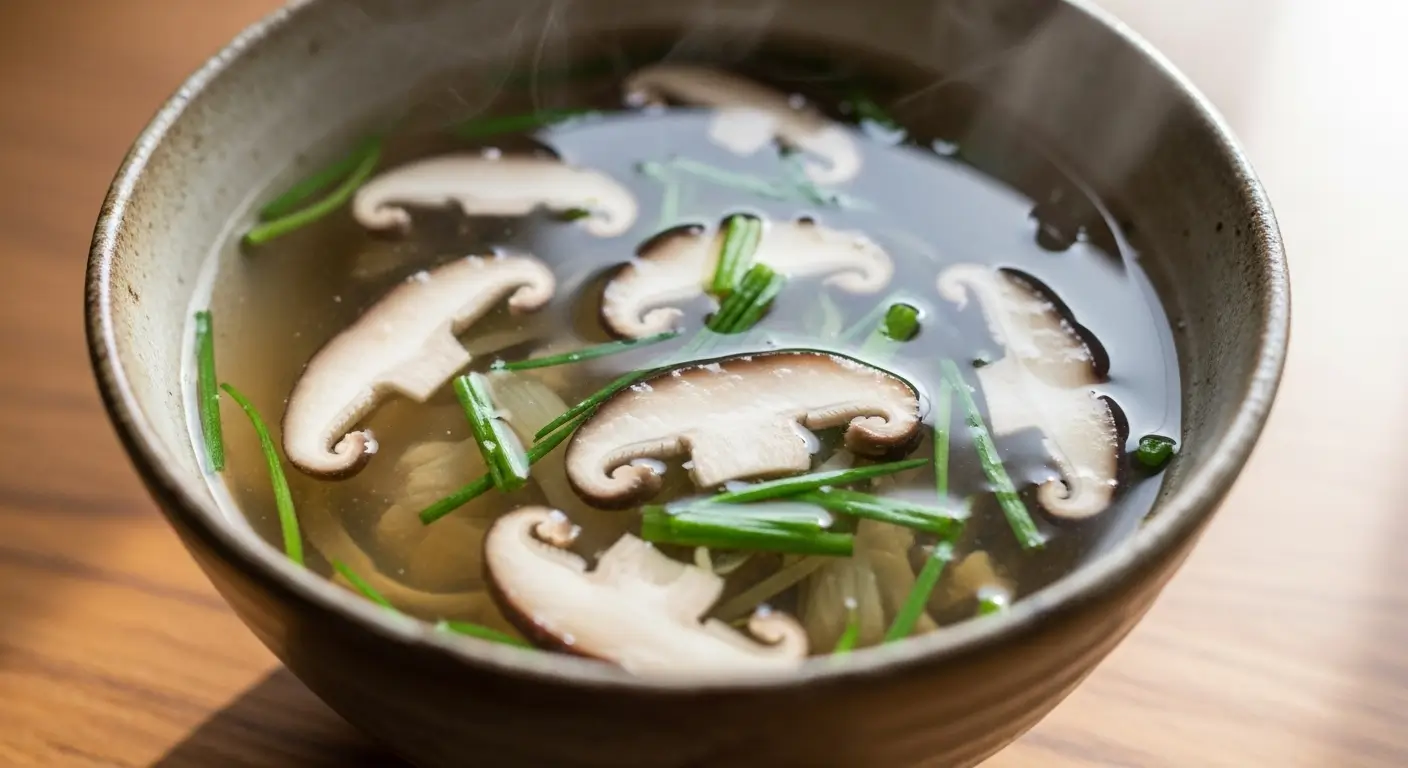Japanese clear soup is one of those things that looks so simple but is actually SO flavorful when you make it right. I first tried making this after going to a hibachi restaurant and becoming obsessed with that light, savory broth they serve before the meal.
Now here’s the thing—I messed this up twice before figuring out what I was doing wrong. Version 1.0 tasted like hot water with a hint of sadness. Not good.
Table of Contents :
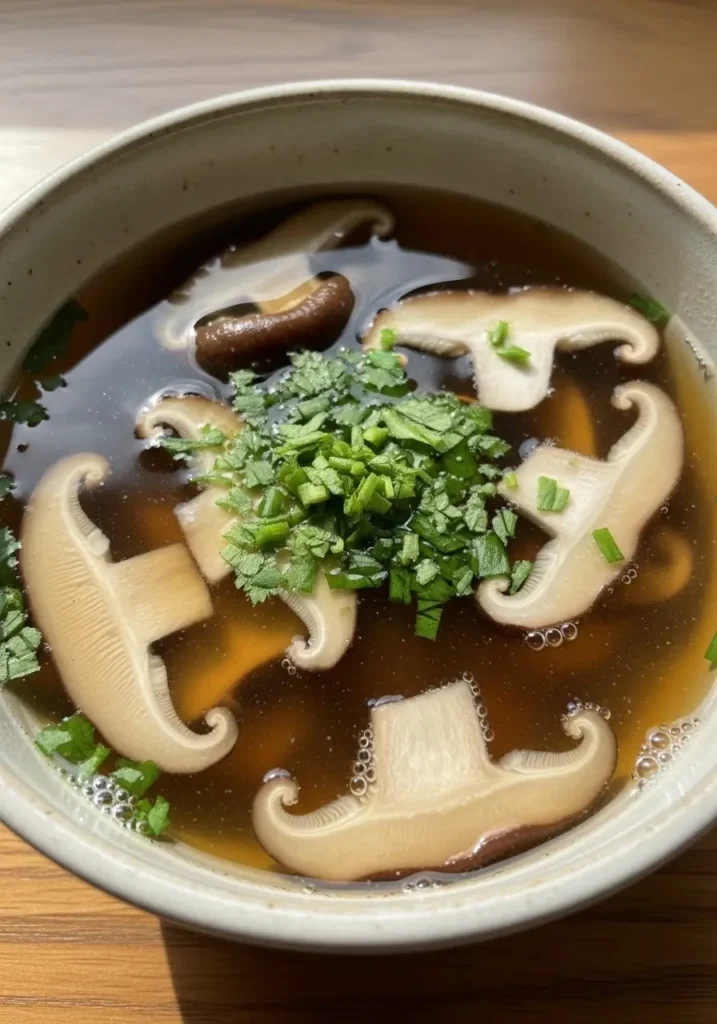
What Makes Japanese Clear Soup Special :
Look, I’m gonna be honest—this soup is all about the dashi broth. Dashi is the foundation of basically all Japanese cooking, and it’s made from kombu (dried kelp) and katsuobushi (bonito flakes). Sounds fancy, but it’s actually pretty simple once you get the hang of it.
The soup itself is called Osumashi or Sumashijiru or sometimes Suimono depending on who you ask. It’s a clear, delicate broth with just a few ingredients that let the dashi really shine.
What frustrated me at first was that you can’t rush the dashi. I tried to speed it up once by boiling everything aggressively and ended up with bitter, cloudy soup. Disaster. Complete disaster.
Ingredients for Japanese Clear Soup :
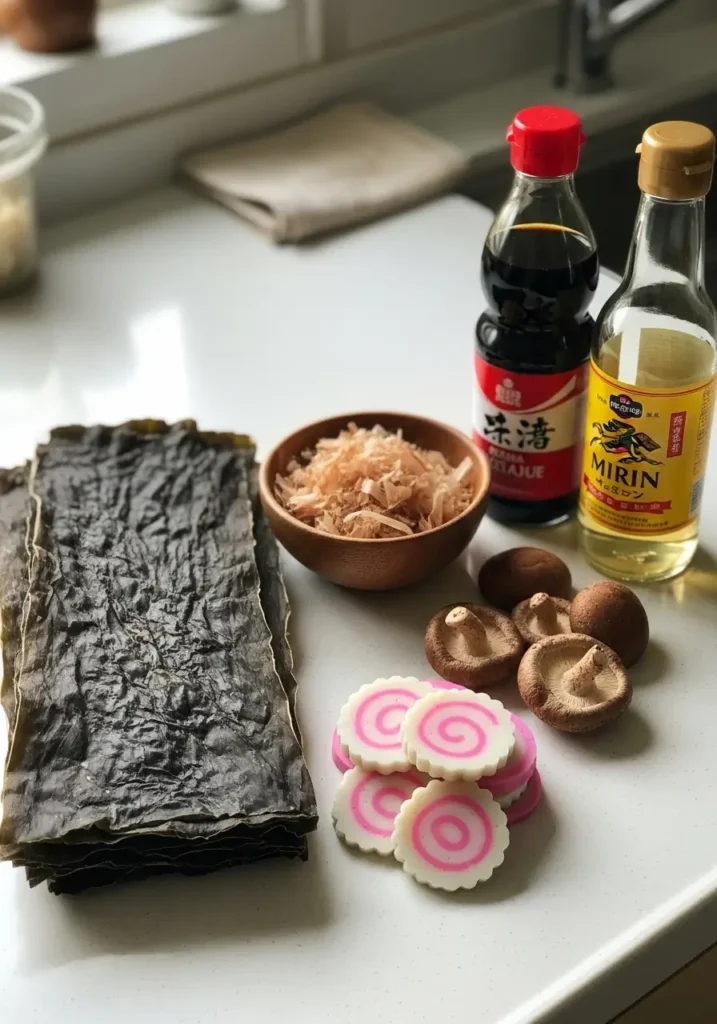
Here’s what you need for authentic Japanese clear soup:
For the Dashi (Broth):
Kombu – About 4×4 inch piece (10g). This is dried kelp and you can find it at Asian grocery stores or on Amazon. Good luck finding it at regular supermarkets though.
Katsuobushi – About 1 cup packed. These are bonito flakes (dried fish flakes). They look like wood shavings but smell fishy.
For the Soup:
Light Soy Sauce (Usukuchi) – 1-2 teaspoons. You can use regular soy sauce if that’s what you have, but light soy sauce keeps the broth clear and pretty.
Salt – Just a pinch to ½ teaspoon.
Mirin – 1 teaspoon. This adds a subtle sweetness.
Sake – 1 tablespoon, optional. Adds depth to the flavor.
Shiitake Mushrooms – 1-2 mushrooms, sliced thin. These add umami and look elegant in the soup.
Kamaboko – 6-8 slices. This is a fish cake that you can find in the refrigerated section of Asian markets. It’s got this pink swirl on the outside that makes it look really pretty.
Mitsuba – A few sprigs. This is Japanese parsley and it’s harder to find, so you can skip it or use regular parsley or cilantro leaves instead.
Green Onions – For garnish. I always have these on hand anyway.
How to Make Authentic Japanese Clear Soup :
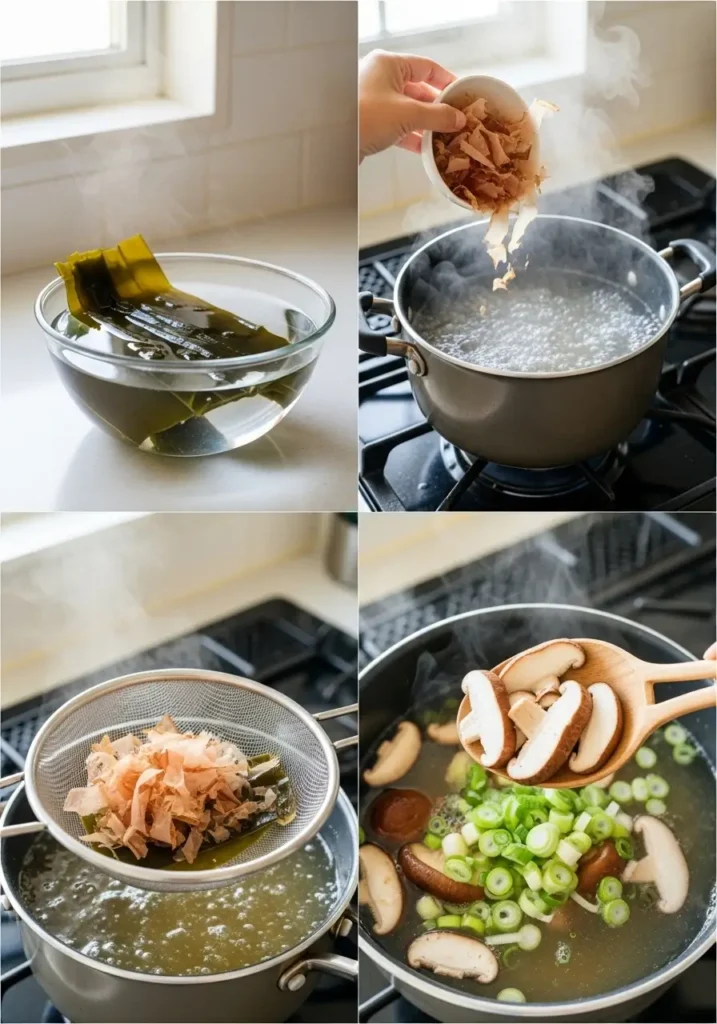
This takes about 50 minutes total, but most of that is just steeping time where you’re not doing anything.
Step 1: Put your kombu and water in a pot and let it steep for at least 30 minutes. Ideally 2-3 hours if you have time. I usually do this in the morning and let it sit all day. The key is—oh wait, I should mention—don’t wash the white powdery stuff off the kombu. That’s where all the umami flavor is. Trust me on this one.
Step 2: After steeping, put the pot on medium-low heat and SLOWLY bring it to almost boiling. This should take about 10 minutes. Watch it carefully.
Step 3: Right before the water starts boiling, remove the kombu. If you leave it in too long the broth gets slimy and bitter. Learned that the hard way.
Step 4: Add your katsuobushi (bonito flakes) and bring it back to a boil. Once it’s boiling, reduce heat and simmer for just 30 seconds to 3 minutes. Then turn off the heat.
Step 5: Let the bonito flakes sink to the bottom for about 10 minutes. Meanwhile you can prep your mushrooms and other ingredients.
Step 6: Strain the dashi through a fine-mesh sieve. Your dashi is done and it should look clear and smell amazing.
Step 7: Pour the dashi back into a clean pot and bring to a gentle simmer.
Step 8: Add soy sauce, salt, mirin, and sake if using. Stir to combine.
Step 9: Add your sliced shiitake mushrooms and kamaboko. Simmer for about 5 minutes until the mushrooms are tender.
Step 10: Taste and adjust the seasoning. You might need more salt or soy sauce depending on your preferences.
Step 11: Ladle into bowls and garnish with mitsuba or green onions.
Total active cooking time? Maybe 20 minutes.
My Real Tips for Perfect Japanese Clear Soup :
Don’t Skip the Steeping Time
So, um, basically what happens is the kombu needs time to release its flavor into the water. If you try to rush this by just boiling it, you’ll get a gross slimy texture and bitter taste. I tried this once when I was in a hurry and it was awful.
Use Dashi Packets If You’re Busy
Sometimes life happens and you don’t have 50 minutes to make dashi from scratch. On those occasions, you can use instant dashi packets or dashi powder. I keep some in my pantry for emergencies. It’s not quite as good as homemade but it’s still pretty decent.
The Broth Should Be Clear
The whole point of this soup is that it’s elegant and clear. If your broth is cloudy, you probably boiled the kombu too long or didn’t strain it well enough.
Light Soy Sauce Makes a Difference
Regular soy sauce will darken the broth and make it look muddy. Light soy sauce (usukuchi) keeps everything clear and beautiful. You can find it at Asian grocery stores.
Don’t Overcrowd the Soup
Japanese clear soup is supposed to be minimal and elegant. Just a few pieces of mushroom, kamaboko, and garnish. It’s not a stew. Less is more here.
What to Serve with Japanese Clear Soup :
This soup is traditionally served as an appetizer before the main meal at Japanese restaurants. It’s light and flavorful and doesn’t fill you up.
Pair it with:
My neighbor Sarah swears by serving this when she’s sick. Says it’s like Japanese chicken soup. The dashi is really soothing and warming.
Easy Version with Store-Bought Broth :
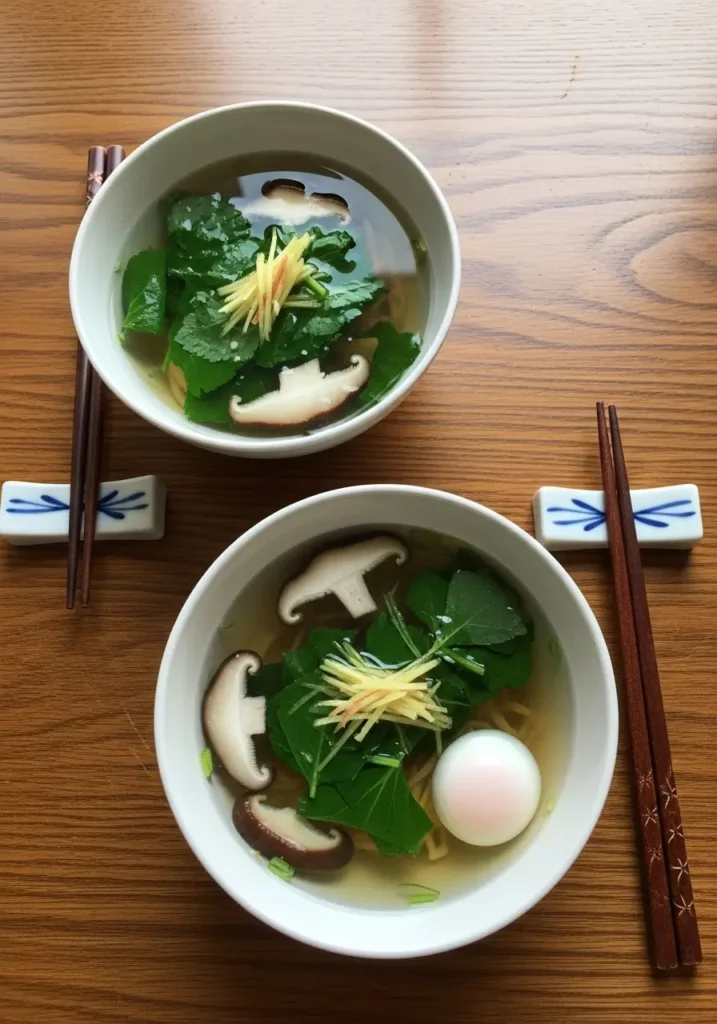
Actually, you know what? If you can’t find kombu and bonito flakes, you can make a simplified version with chicken or beef broth. It won’t be traditional Japanese clear soup, but it’ll still be delicious.
Just use 4 cups of good quality low-sodium broth, add some sautéed onions, garlic, ginger, mushrooms, and season with soy sauce and sesame oil. I’ve made this version when I’m too lazy to deal with the whole dashi process and honestly it’s still really good.
My 8-year-old refuses to eat anything with visible vegetables, but somehow loves this soup. Probably because it’s so simple and light.
Storage Tips :
Dashi keeps in the fridge for about 3-4 days. You can also freeze it in ice cube trays and use it whenever you need it. Super convenient.
The finished soup is best eaten fresh, but you can store leftovers in the fridge for a day or two. Just reheat gently on the stove.
Wait, I almost forgot—you can repurpose the used kombu and bonito flakes after making dashi. I usually make rice seasoning or furikake with them instead of throwing them away.
If you try this best Japanese clear soup recipe, let me know how it turns out! Have you ever made dashi from scratch? Drop a comment because I’m curious if anyone else struggled with it at first like I did 🙂
Happy cooking! (and may your dashi never turn bitter) 🍵
Best Japanese Clear Soup Recipe
Best Japanese clear soup (Osumashi) recipe with authentic dashi broth made from kombu and bonito flakes. Features shiitake mushrooms and kamaboko fish cake in an elegant, light, and flavorful broth. Perfect appetizer for any Japanese meal.
Ingredients
- 4 cups water
- 1 piece (10g) kombu (dried kelp), 4x4 inches
- 1 cup katsuobushi (dried bonito flakes), packed
- 2 teaspoons light soy sauce (usukuchi)
- ½ teaspoon salt
- 1 teaspoon mirin
- 1 tablespoon sake (optional)
- 2 shiitake mushrooms, thinly sliced
- 8 slices kamaboko (fish cake)
- 4 sprigs mitsuba (Japanese parsley) or green onions for garnish
Instructions
- Step 1Put water and kombu in a large pot or container. Let steep at room temperature for at least 30 minutes, ideally 2-3 hours. Do not wash the white powdery substance on the kombu as it contains umami flavor.
- Step 2Place the pot with kombu and water on medium-low heat. Slowly bring to almost boiling over about 10 minutes. Watch carefully.
- Step 3Just before the water starts boiling (when small bubbles appear), remove the kombu from the pot. If left too long, the broth will become slimy and bitter.
- Step 4Add katsuobushi (bonito flakes) to the pot and bring back to a boil. Once boiling, reduce heat to low and simmer for 30 seconds to 3 minutes. Turn off heat.
- Step 5Let the bonito flakes sink to the bottom for about 10 minutes. Meanwhile, prepare soup ingredients. Strain the dashi through a fine-mesh sieve into a bowl. The awase dashi is now ready.
- Step 6Pour the strained dashi back into a clean pot and bring to a gentle simmer. Add light soy sauce, salt, mirin, and sake if using. Stir to combine.
- Step 7Add sliced shiitake mushrooms and kamaboko fish cake slices to the broth. Simmer for about 5 minutes until mushrooms are tender.
- Step 8Taste the soup and adjust seasoning with more salt or soy sauce if needed. Ladle into individual bowls and garnish with mitsuba leaves or chopped green onions. Serve immediately.

